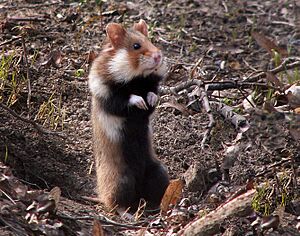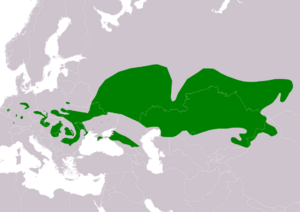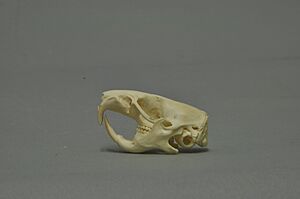European hamster facts for kids
Quick facts for kids European Hamster |
|
|---|---|
 |
|
| Hamster photographed at Vienna Central Cemetery | |
| Conservation status | |
| Scientific classification | |
| Genus: |
Cricetus
|
| Species: |
cricetus
|
 |
|
| European hamster range (green) | |
| Synonyms | |
|
List
Cricetus albus Fitzinger, 1867
Cricetus babylonicus Nehring, 1903 Cricetus canescens Nehring, 1899 Cricetus frumentarius Pallas, 1811 Cricetus fulvus Bechstein, 1801 Cricetus fuscidorsis Argyropulo, 1932 Cricetus germanicus Kerr, 1792 Cricetus jeudii Gray, 1873 Cricetus latycranius Ognev, 1923 Cricetus nehringi' Matschie, 1901 Cricetus niger Fitzinger, 1867 Cricetus nigricans Lacépède, 1799 Cricetus polychroma Krulikovski, 1916 Cricetus rufescens Nehring, 1899 Cricetus stavropolicus Satunin, 1907 Cricetus tauricus Ognev, 1924 Cricetus tomensis Ognev, 1924 Cricetus varius Fitzinger, 1867 Cricetus vulgaris Geoffroy, 1803 Mus cricetus Linnaeus, 1758 |
|
The European Hamster (Cricetus cricetus) is also known by other names. These include the Eurasian Hamster, black-bellied hamster, or common hamster. It is the only species of hamster in its group, called the Cricetus genus. These hamsters live in grasslands and similar areas across a large part of Europe and Asia. This range stretches from Belgium all the way to the Altai Mountains in Russia.
Long ago, people saw them as pests on farms and hunted them for their fur. Sadly, their numbers have dropped a lot in recent years. Today, they are considered critically endangered, meaning they are at high risk of disappearing forever. The biggest dangers to them are modern farming methods, losing their homes, and being hunted by farmers.
Contents
What Does the European Hamster Look Like?
The European Hamster has brown fur on its back with white spots. Its chest and belly are black, making it easy to spot. It also has a short, furry tail. This hamster is much bigger than the Syrian or dwarf hamsters you might see as pets. In fact, it is the largest known type of hamster!
These hamsters usually weigh between 220 and 460 grams (about 8 to 16 ounces). They can grow to be 20 to 35 centimeters (8 to 14 inches) long. Their tail adds another 4 to 6 centimeters (1.5 to 2.5 inches) to their length. Like all rodents, they have a specific set of teeth designed for gnawing. If kept in a safe place like a zoo, a European Hamster can live for an unusually long time for a rodent, sometimes up to eight years.
How Do European Hamsters Behave?
The common hamster is mostly active at night (nocturnal) or during twilight hours (crepuscular). They live in a complex system of tunnels and rooms underground, called a burrow. Their diet includes seeds, beans, root vegetables, grasses, and insects.
They are very good at carrying food. They use their stretchy cheek pouches to carry food back to special storage rooms in their burrow. These storage rooms can be quite large. On average, they hold about 2 to 3 kilograms (4.4 to 6.6 pounds) of food. However, some have been found with an amazing 65 kilograms (143 pounds) of food! European Hamsters hibernate, or go into a deep sleep, from October to March. During this time, they wake up every five to seven days to eat from their stored food. Most European Hamsters prefer to live alone.
Life Cycle and Reproduction
Adult European Hamsters are ready to have babies when they are about 43 days old. They usually breed from early April until August. A mother hamster carries her babies for 18 to 20 days. Each time she gives birth, she can have anywhere from three to 15 young hamsters. The baby hamsters are ready to stop drinking their mother's milk when they are about three weeks old.
Where Do European Hamsters Live?
European Hamsters typically live in low-lying farmland. They prefer soft, rich soils like loam or loess. However, you might also find them in meadows, gardens, or near hedges. Their natural home stretches from Belgium and Alsace in the west, all the way to Russia in the east. They can also be found as far south as Bulgaria. A notable group of these hamsters lives in the Vienna Central Cemetery in Austria.
Protecting the European Hamster
In 2011, a very important court, the Court of Justice of the European Union, made a ruling. They said that France had not done enough to protect the European Hamster. The court warned France that it could face large fines if it didn't change its farming and building rules to help the hamsters. By 2014, France had started a special program to breed hamsters in captivity. The goal was to release 500 hamsters each year into fields where farmers were paid not to harvest their crops. This helped create safe spaces for the hamsters.
In 2020, the European Hamster was officially listed as critically endangered worldwide on the IUCN Red List. This means they are very close to extinction. Scientists are still trying to fully understand why their numbers have dropped so much. Some reasons include losing their homes because of modern farming and new roads that split up hamster groups. Climate change, hunting for fur in the past, and even light pollution also seem to harm their populations. Farming, new buildings, and being hunted are considered the biggest threats to these animals.
One good thing for conservation efforts is that European Hamsters breed easily when they are cared for by humans. Because of this, there are special programs to breed them in places like Belgium, France, Germany, Poland, and Ukraine. These programs help increase their numbers and hopefully release them back into the wild.




